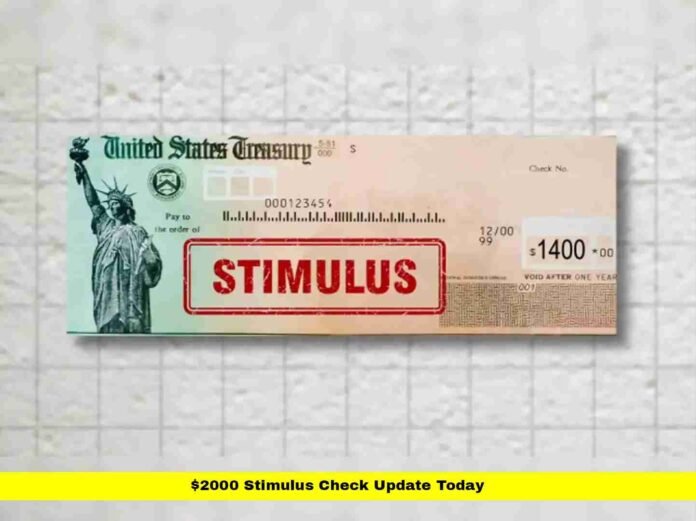The $2000 stimulus check update today shows that no new federal payments have been approved, and no distribution timeline exists as of this morning. Discussions about issuing a $2,000 relief payment continue, but the proposal has not advanced into active legislation, meaning no checks are being processed or scheduled for delivery.
Current Status of the $2000 Proposal
As of today, the proposal to send a $2,000 stimulus payment remains under review within federal leadership circles. There is interest in offering financial relief, but the plan has not moved into the legislative phase.
Congress has not introduced or voted on a bill that would authorize $2,000 payments. Without that step, the Treasury Department cannot begin any form of distribution or logistical planning.
Officials have emphasized that the idea is still being evaluated for cost, eligibility, funding sources and long-term economic impact.
Key Details Being Reviewed
Federal discussions revolve around several important factors:
- How many Americans would qualify
- Whether payments would be one-time or part of an ongoing program
- How the payment would be funded
- Whether income caps should be adjusted from past stimulus rounds
- How quickly distribution could occur if legislation passes
No final decisions have been made. Until Congress acts, the proposal stays in the exploratory stage.
Why Payments Are Not Being Sent Out Yet
The government cannot send money directly to Americans without a law authorizing the payment. This is the primary reason the $2,000 stimulus payment has not moved forward.
Other factors delaying movement include:
- Budget constraints
- Debate over the use of tariff revenue or alternative funding
- Uncertainty about the number of eligible recipients
- Concern about impact on the federal deficit
These issues must be resolved before a bill can progress.
Who Could Qualify if the Proposal Advances
While the plan remains unapproved, early outlines suggest that eligibility could resemble earlier stimulus rounds:
- Middle- and lower-income earners
- Individuals filing taxes annually
- Seniors receiving Social Security benefits
- People on disability programs
- Veterans receiving federal support
Because no bill has been introduced, exact thresholds and rules are not available yet. Anyone promising specific eligibility rules before legislation is passed is not providing verified information.
Estimated Cost of a $2000 Payment
Early estimates show that a nationwide $2,000 payment would be a major financial undertaking.
Here are the rough cost projections:
- If 150 million people qualify → around $300 billion total
- If eligibility is broader → cost increases significantly
- If recurring payments are included → cost could exceed $1 trillion annually
These cost concerns are central to the ongoing debate.
What Needs to Happen Next
For the $2000 stimulus check update today to change into an approved program, several steps must occur:
- A bill must be introduced in Congress.
- Committees must review, amend and vote on it.
- The full House and Senate must pass the legislation.
- The President must sign the bill into law.
- The Treasury Department must set up the distribution system.
- Only then can payment dates be announced.
None of these steps have taken place yet.
What Americans Should Do Right Now
If you’re waiting for a possible $2,000 payment, here are practical steps to stay prepared:
- Ensure your mailing address and bank information are updated with the IRS.
- File your taxes on time, as recent tax information is typically used for eligibility checks.
- Watch for official announcements rather than social-media rumors or misleading posts.
- Avoid scams promising early access to payments or asking for personal information.
Preparation helps, but expectations should remain grounded until legislation is introduced.
Impact on Households if the Proposal Moves Forward
A $2,000 payment would offer meaningful support for many Americans facing rising expenses such as:
- Rent and housing costs
- Groceries
- Utilities
- Gas prices
- Medical bills
- Credit card debt
Even so, policymakers must weigh the benefits against budget limitations and economic risks.
Public Reaction and Economic Context
The idea of a $2,000 stimulus check continues to draw strong interest across social media and public forums. Many Americans express support for direct relief due to ongoing economic pressures.
At the same time, experts urge caution, pointing out that additional stimulus could increase federal debt or fuel inflation. Both concerns play a role in the slow pace of policy development.
Where Things Stand Today
The $2000 stimulus check update today remains unchanged: no payments have been approved, and no official timeline has been released. Discussions inside the federal government continue, but concrete action has not yet begun.
If you’re following the potential $2,000 payment, share your thoughts below — every perspective adds to the conversation.
